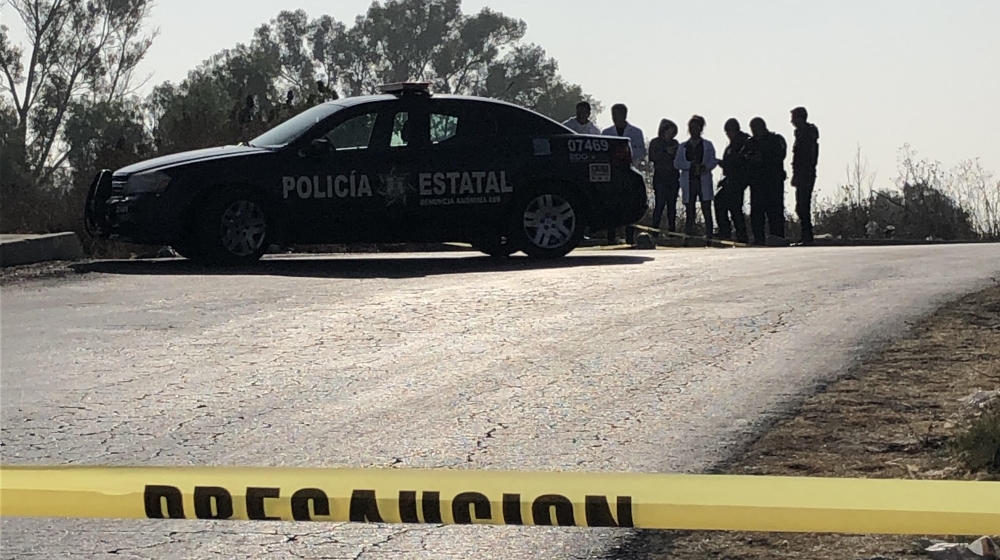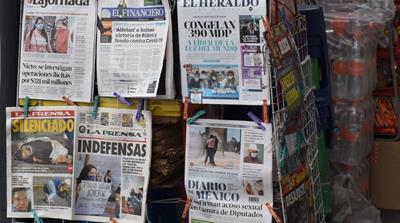Profiting from exploitation and violence against Mexican women
Critics say Mexico’s crime tabloids make the dead victims twice over and sensationalise gender-based violence.

Mexico City, Mexico – Mexico’s graphic crime tabloids have long profited from documenting violence that since the start of the country’s so-called “war on drugs” breaks records with each passing year.
On newsstands across Mexico, lurid photos of the dead share space with sports stars and erotic models in popular newspapers known as nota roja or “red news.”
Keep reading
list of 4 itemsMembers of London’s Garrick Club vote to let women join for first time
Why has Australia declared a ‘national crisis’ over violence against women?
Manhattan prosecutors announce retrial for film producer Harvey Weinstein
But after two tabloids in Mexico City ran leaked photos of the body of Ingrid Escamilla, a 25-year-old woman who in February was stabbed, skinned and dismembered by her attacker, the genre has faced scrutiny over its treatment of the dead and in particular, female victims of violence.
Critics say the papers’ uncensored photos and lewd headlines make the dead victims twice over and reinforce gender-based violence. But tabloid reporters say their work keeps readers informed of staggering levels of bloodshed in a country engulfed by violence.
Activists in Mexico have organised a mass strike on March 9, in response to rising gender-motivated attacks and what many women call an unresponsive government.
On “A Day Without Us,” women and girls across Mexico have been asked to skip school, work and any other activities outside their homes.

Benefitting the public?
Arianna Alfaro is a nota roja reporter for La Prensa, a 91-year old paper whose delivery truck was set ablaze by protesters in the capital last month days after it published part of a photo of Escamilla’s corpse on its front page.
Without the coverage Mexico’s nota roja provide, Alfaro said, the public – including those protesting violence against women – would never know about the grisly crimes they are challenging.
“There’s an importance to having these images,” Alfaro said. “If we hadn’t published it, [Ingrid] would be another case we never knew about.”
Ten women in Mexico are killed every day, according to the National Statistics Institute, up from eight in 2016. More than 90 percent of these cases are never solved.
In the weeks since Escamilla’s murder, activism in Mexico around women’s rights has reached a boiling point, fuelled in part by outrage more than Escamilla’s killing and the gruesome February murder of Fatima Aldriguetti Anton, a seven-year-old girl from southern Mexico City whose body was discovered in a plastic bag days after she went missing from school.
There's an importance to having these images
Women have taken to the streets demanding that the government take action against the killings of women and girls due to their gender, a crime known as femicide. Protesters also vented their frustrations with the media, spray-painting slogans like “complicit media” and “machista (male chauvanist) press” around the city, including outside La Prensa’s office.
Feminist groups say they are not calling for the censorship of crimes. Instead, they say they want the papers to treat gender-based violence with more sensitivity and use headlines that are less sensationalist.
“We need a narrative that goes beyond the morbid,” said Maria Flores, a member of Crianza Feminista, a feminist collective based in the capital.
“Journalism with fewer adjectives,” she said.”A straight retelling of events.”

Catering to men
Luis Carriles, the director of La Prensa, said while he recognises that violence should be covered seriously, the genre survives thanks to readers with an appetite for gore.

He said he appreciated the demands feminist groups raised in a recent meeting with La Prensa after the protests that followed the paper’s decision to run the photo of Escamilla’s corpse.
“We grasp perfectly well that death is a serious topic,” Carriles said in La Prensa’s downtown office. “But we also have to understand that we owe ourselves to a consumer and a public that reads us every day. We have to find a balance,” he said.
Some media experts say nota roja papers target a largely male audience. Headlines accompanying brutal images often describe murders as crimes of passion.
“It’s become something that’s seen as very masculine,” said Pablo Piccato, a professor of history at Columbia University who has written about crime and journalism in Mexico.
“They know that pictures sell more than the follow-up of crime,” he said.
A body count
Mexico City’s nota roja reporters say the dizzying pace of violence in the capital leaves little time to explore the reasons behind killings. Often, the dead are not identified.
Mexico City registered 1,397 murders in 2019, up 57 percent from 2015, according to Interior Ministry data.
In this environment, the genre can function as a body count of the deceased.
One recent morning, it was barely 8am when a crime photographer for the crime section of Mexico’s state news agency Notimex got wind of another body: a second man apparently strangled to death.
A colleague sent the photographer the GPS location of the body, just 1 kilometre (0.6 miles) away from the first.
Minutes later, the photographer arrived at the scene, on the northern reaches of Mexico City. A pink hood covered a young man’s face. The photographer crouched near a scrum of police to find the best angle.
The next day, the photos taken that morning of the two victims covered newsstands across the city. One nota roja would capture the killings with a four-word headline: “Two of a kind.”

Local crime
In Mexico City, nota roja papers sell more copies than serious newspapers like Reforma, El Universal, El Financiero and others, which draw large online readerships.
One reason may be their price tag. In Mexico City, La Prensa sells for 8 Mexican pesos or about $0.40. Prestige papers like El Universal or Reforma cost about 20 pesos ($1).
Another is that nota roja papers like La Prensa spill more ink covering crime than their better-respected peers, often at a local level.

Alejandro Nava, 50, reads Pasala, a popular nota roja every day, he said. He reads it, he said, “to know what’s happening in Tepito,” a tough neighbourhood north of Mexico City’s historic centre known for its illicit markets and high crime.
As violence in Mexico City rises year after year, people grow desensitised to the bloody scenes that fill the nota roja, he said. Still, there are exceptions. Nava, who works in construction, said he felt shocked for days and depressed after reading about young Fatima’s horrific killing.
But he does not blame the papers for printing the images.
“Horrible things happen in the city,” he said. “But you have to read to find out about them.”